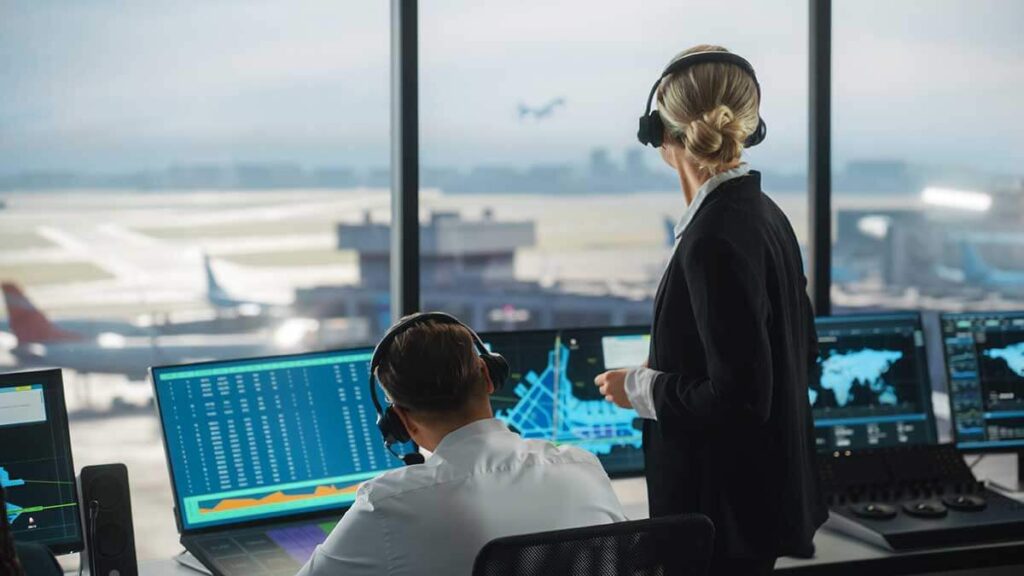By: Sarah Nilsson, AG Drone & AAM Law Ambassador
As the dust settles on President Trump’s return to the White House, the Advanced Air Mobility (AAM) and drone industries find themselves at a crossroads. Will they soar to new heights or face turbulence in this administration’s airspace? Let’s navigate through the policy shifts and potential impacts on the future of American aviation.
The Administration’s Emerging Aviation Agenda
President Trump’s vision for American air dominance is clear. In his 2023 Agenda 47 speech, he declared, “Just as the United States led the automobile revolution in the last century, I want to ensure that America, not China, leads the revolution in air mobility.” This stance signals a potential acceleration of AAM development, viewing it as a critical battleground in the technological race against China. Trump’s plan to create 10 futuristic “Freedom Cities” with integrated electric vertical takeoff and landing vehicles (eVTOLs) underscores this commitment.
Similarly, with regard to drones, the Trump Administration may support policies aimed at reducing dependence on Chinese-made drones, mainly DJI products. Along these lines, President Trump may encourage U.S.-based companies to increase production of drones. Whether or not his team will offer incentives or grants to do so remains to be seen.
Nilsson’s Prediction: Trump’s pro-innovation stance may catalyze domestic AAM and drone development, but regulatory hurdles will likely persist.
Regulatory Turbulence
While the administration’s approach to AAM and drones will likely be characterized by increased support for innovation, it is clear that reduced federal workforce and regulation remain a key part of its agenda.
The FAA’s proposed rule for expanded drone operations beyond visual line of sight (BVLOS) faces an uncertain future. In late 2024, the previous administration pushed a draft rule through the bureaucratic process but never finalized it. It is expected that the Trump Administration will be supportive of this rulemaking.
However, President Trump has made clear his intention to reduce regulation at the federal level, and air transportation will certainly be no exception. Specifically, on January 20, 2025, President Trump issued a memorandum directing executive branch agencies to:
- (1) refrain from proposing, issuing, or publishing any rules, regulations, or guidance documents until a department or agency head appointed by President Trump reviews and approves it;
- (2) immediately withdraw any rules that have been sent to the Office of the Federal Register but not yet published pending review and approval; and
- (3) consider postponing for 60 days from January 20 the effective date for rules that have been published in the Federal Register or rules that have been issued but not taken effect. This move has effectively grounded the BVLOS rule and left drone operators in a regulatory limbo.
In light of this Executive Order, in early March, the FAA announced it would temporarily suspend enforcement of the newly enacted SFAR for Powered-Lift, at least through March 20. Unless the suspension is extended further, this should not impact eVTOL manufacturers and air taxi operations and pilot training.
While advocates like House Transportation & Infrastructure Committee Chairman Sam Graves (R-MO) push for expedited rulemaking, this regulatory freeze could stall progress. The lack of clear guidelines could also hinder innovation and investment in the sector.
Nilsson’s Prediction: Regulatory uncertainty will create short-term setbacks for drone operations and also potentially slow down AAM.

Air Traffic Control: Modernize or Privatize?
The aging U.S. air traffic control (ATC) system presents a significant challenge to drone and AAM integration. A September 2024 GAO report revealed that 51 of the FAA’s 138 systems were unsustainable. Some modernization projects are not scheduled for completion for another decade or more.
On February 14, 2025, the 31 Democrats on the U.S. House Transportation and Infrastructure Committee urged Transportation Secretary Sean Duffy to prioritize key measures in the 2024 FAA Reauthorization Bill that would accelerate and fund ATC updates, runway enhancements, and controller and other safety personnel hiring. They also noted the need to upgrade the aging ATC equipment and facilities. The lawmakers said, “Fifty-eight of these systems have critical operational impacts on the safety and efficiency of the NAS (national airspace system).”
Yet the Trump administration has previously floated the idea of ATC privatization. Such privatization or a concept to make ATC a for-profit endeavor and/or to separate it from the FAA, could be raised again in the current Administration. Of note, Project 2025 supports the separation of ATC from the FAA.
Industry opposes this move. A February 2025 joint letter from organizations like the National Business Aviation Association (NBAA), Air Line Pilots Association (ALPA) and Association for Uncrewed Vehicle Systems International (AUVSI) called for ATC reform without privatization, emphasizing the need for modernization and efficiency improvements. It specifically stated, “…we must support air traffic controller workforce hiring and training, modernize and deploy state-of-the-art air traffic control facilities and equipment, implement procurement and program efficiencies and facility realignment, and address budget reforms for the Airport & Airway Trust Fund. We are aligned on not pursuing privatization of U.S. air traffic control services and believe it would be a distraction from these needed investments and reforms.”
Project 2025, the apparent blueprint for the Trump administration, supports separating ATC from the FAA.
Nilsson’s Prediction: ATC modernization will proceed slowly, with privatization still on the table but reforms more likely. Upgrades to ATC and increased digitization could mean that eVTOLs should be more efficiently handled and integrated into the NAS.
The Electric Revolution: Stalled or Recharged?
President Trump’s revocation of Biden’s 50% electric vehicle (EV) target by 2030 signals a shift in transportation priorities. However, this doesn’t necessarily spell doom for eVTOLs. The administration’s focus on beating China in air mobility innovation could provide a counterbalance to the broader pullback on EVs.
The future of eVTOLs in the Trump 2.0 era will likely depend on market forces and technological advancements rather than government mandates. This approach aligns with the administration’s preference for consumer choice and market-driven innovation.
Nilsson’s Prediction: eVTOL development will continue, driven by private sector innovation rather than government mandates.

Key Players in the AAM Landscape
As the drone and AAM industries navigate the new political landscape under the Trump administration, several key government agencies and new leaders will shape the future of these emerging sectors. Their decisions and policies will play a crucial role in determining the pace of innovation, regulatory frameworks, and overall development of emerging aviation in the United States. Here’s a run down of a few:
Department of Transportation
Former Rep. Sean Duffy (R-Wis) was President Trump’s pick for DOT secretary. He was sworn in on January 28, 2025. Under Duffy, the DOT is expected to champion technical and safety initiatives critical to aviation while rolling back certain Obama and Biden-era policies. His first act was signing a memorandum to eliminate the EV mandate.
Vertical Aviation International called Duffy “uniquely qualified” to champion technical, regulatory and safety initiatives critical to the aviation industry, while the ALPA also praised Duffy’s “commitment to aviation and transportation issues that most impact Americans.”
It was expected that Duffy would eliminate Diversity Equity and Inclusion (DEI) for pilots and air traffic controllers, especially after Trump’s January 2025 Presidential Memorandum terminating a Biden Administration FAA hiring policy that prioritized DEI “over safety and efficiency.” This marks a significant shift in departmental focus. We should also expect Duffy to adopt Project 2025 aviation policies.
Federal Aviation Administration
Chris Rocheleau became the first FAA official to be sworn in by the Trump Administration. According to the NBAA, he served the FAA for over 20 years in multiple roles, including as the acting associate administrator for aviation safety, chief of staff, assistant administrator for policy, international affairs and environment, executive director for international affairs, and director of the office of emergency operations and investigations.
With Rocheleau at the helm, as of Feb 11, 2025, a NOTAM is back to being a Notice to Airmen after the Trump Administration issued an order to reverse a Biden-era gender-neutrality move from 2021 that changed the term to Notice to Air Missions.
Meanwhile, with DEI changes happening, the FAA faces the significant challenge of balancing safety concerns with the pressure to accelerate AAM integration.
NASA
Under acting administrator Janet Petro, NASA seems poised to continue its role in providing critical data for AAM development. Petro had served as the director of NASA’s Kennedy Space Center since 2007.The agency’s goal of fostering a flourishing AAM industry by 2030 remains unchanged. This offers a beacon of continuity amidst shifting political winds.
Nilsson’s Prediction: Key leader focus on Project 2025 will likely lead to significant deregulation and restructuring of the U.S. aviation industry. It may potentially accelerate technological advancements but also raise concerns about equity, rural air service and environmental impacts. Interagency coordination will be key to drone and AAM progress, with NASA’s research playing a crucial role in industry development.
Turbulent Skies Ahead
The AAM industry under Trump’s second term faces a complex flight path. While the administration’s pro-innovation stance and desire to outpace China could provide tailwinds for development, regulatory uncertainties, workforce cuts and potential budget constraints may create headwinds.
The success of the AAM and drone industries in this political climate will depend on the industry’s ability to navigate these challenges, leveraging private sector innovation while working within a potentially less predictable regulatory environment. As these sectors take off, both will need to balance the promise of advanced technology with the realities of safety, infrastructure and market demand.
Ultimately, the fate of drones and AAM under Trump 2.0 will be determined by a delicate interplay of policy, technology and market forces. While the ride ahead may be turbulent, this author remains hopeful that the destination—a transformed American airspace—remains on the horizon.
Nilsson’s Final Prediction: AAM and drones will advance under Trump, but with a bumpy flight plan marked by regulatory challenges and market-driven progress.
By: Sarah J. Nilsson

